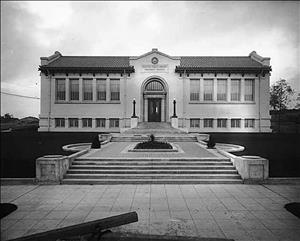In the spring of 1906, the University Branch, The Seattle Public Library opens on University Way (called the "Ave") and 42nd Street, even before the street is paved, as befits an erudite university community.
Within a year the institution moved across the alley from the southwest corner of the “Ave” and 42nd Street into the Methodist Church on Brooklyn Avenue. In August 1910, the library dedicated its own Carnegie-endowment-funded French Renaissance landmark, designed by architects W. Marbury Somervell and Joseph S. Cote, at the northwest corner of 50th Street and 10th Avenue NE (Roosevelt Way).
The site was remote from both the University District’s commercial heart along the "Ave" and the university campus. As late as 1921 the branch librarian complained that it was "off the beaten track." However, following the 1922 opening of Roosevelt High School, the library was regularly swarmed by students first searching for books on their namesake Theodore Roosevelt -- probably an assignment -- and then turning to subjects for school reports and debates. The branch was especially busy during the 1930s when the jobless had more time to read books.
Cornelia and Watson Allen, the philanthropic couple who donated the site, made their gift contingent on the inclusion of an auditorium in the new library. Through the years the structure’s spacious basement auditorium has served as a community center for meetings, lectures, films, and children’s programs. During the two world wars, the big room was used by the Red Cross, a Well-Baby Clinic, and for meetings of the Women’s Air Raid Wardens and the Camp Fire Guardians. It has recently (2001) been repainted and features a permanent exhibit on University District history.

